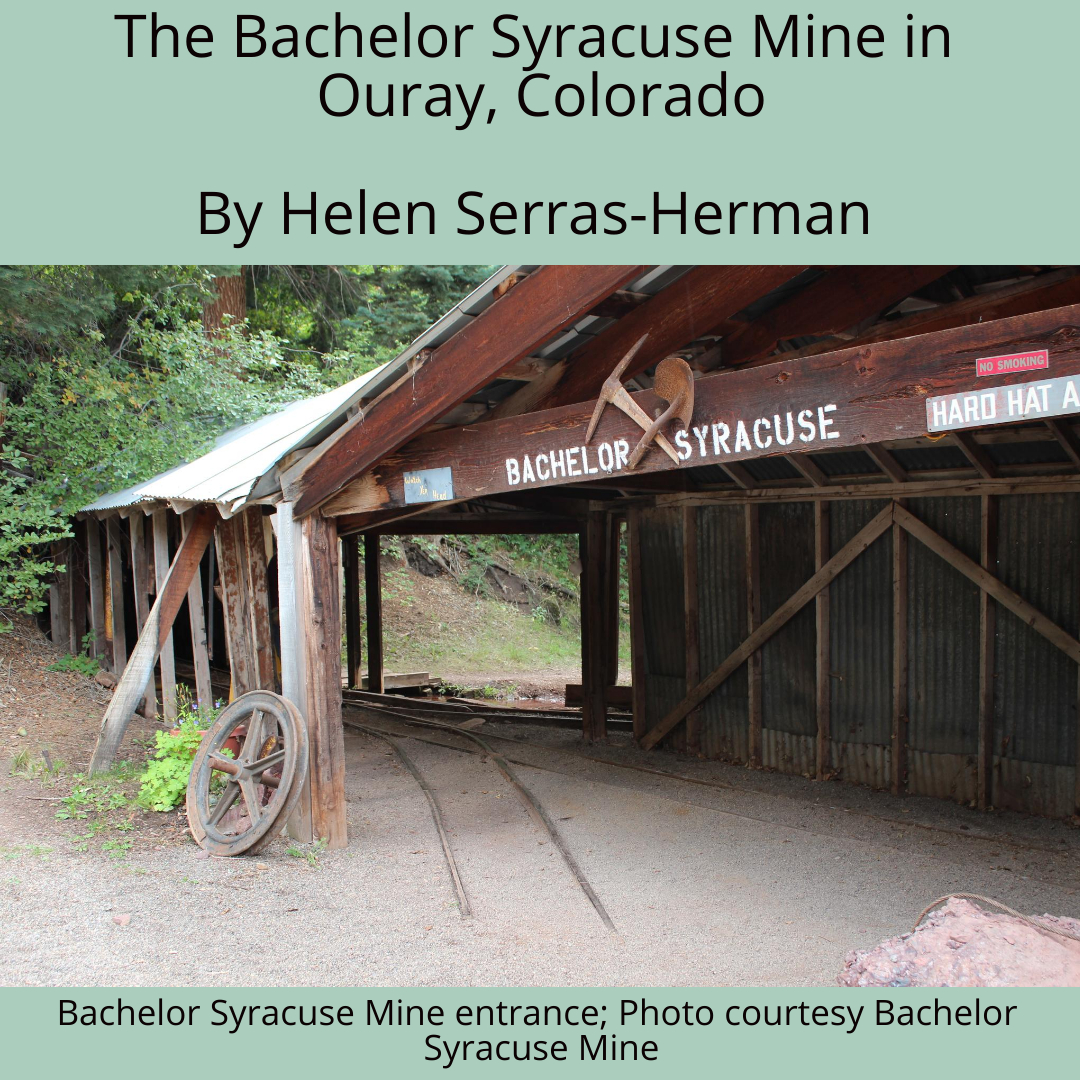The Bachelor Syracuse Mine is located in Ouray, in the heart of the San Juan Mountains and the San Juan Mining District of southwestern Colorado. What better place to learn the rich local mining history than visiting a real gold mine, where guides share the history, the tools, equipment, and mining methods used in the mines.
 Ouray is dubbed “The Switzerland of America”, offering outdoor adventures for both the summer and snow-covered winter months. Photo Andrew Herman
Ouray is dubbed “The Switzerland of America”, offering outdoor adventures for both the summer and snow-covered winter months. Photo Andrew Herman
The town of Ouray was established by prospectors who flocked in the area in the late 1800s seeking gold and silver. Ouray was incorporated in 1876 and took the final name after Chief Ouray of the Ute Native American tribe. Most of the town’s buildings date back to the late 19th century and the entire Main Street is registered as a National Historic District.
 The welcome sign to the Historic Colorado Mining District. Photo Helen Serras-Herman
The welcome sign to the Historic Colorado Mining District. Photo Helen Serras-Herman
Gold veins were discovered there in 1877 when William Weston and George Barber found the Gertrude and Una gold veins six miles south of Ouray. At its height the region boasted 30 active mines. The Camp Bird Mine was established by Thomas Walsh in 1896 who acquired the two veins creating the largest mine in the area. He added a twenty-stamp mill in 1898 and a forty-stamp mill in 1899. The mine has produced over 1.5 million troy ounces of gold and 4 million troy ounces of silver. Walsh sold the mine in 1902. He died a few years later in 1909. His daughter, Evalyn Walsh McLean, is famous for owning the blue Hope Diamond, which was purchased by jeweler Harry Winston, who in 1958 donated to the Smithsonian National Museum of Natural History, where it is today on permanent view.
 Colorado’s mines were most profitable producers of gold and silver rich ores. Photo Helen Serras-Herman
Colorado’s mines were most profitable producers of gold and silver rich ores. Photo Helen Serras-Herman
The towns of Ouray and Silverton
The town of Ouray, with a population of about 1,000 residents, is the county seat for Ouray County. It is twenty three miles north of the historic town of Silverton. Ouray is along the San Juan Skyway Hwy 550, one of the most scenic drives in America, known as the Million Dollar Highway. The road connects the historic mining areas of Silverton and Ouray, along the Uncompahgre River, at elevations spanning from 6,200 near Cortez to 11,008 feet at Red Pass Mountain. Driving on Million Dollar Highway the traveler is rewarded with breath-taking scenery of deep gorges, mountain lakes and dense stands of evergreen trees, a natural alpine environment. I can vividly still remember the steep, winding road down to Ouray, with a 25-mile-per-hour speed limit! But there was a time when there were not even wagon roads, until the need to reach the mining camps carved roads and narrow gauge railroads over the mountain passes.
 The town of Ouray is located in the heart of the San Juan Mountains. Photo Helen Serras-Herman
The town of Ouray is located in the heart of the San Juan Mountains. Photo Helen Serras-Herman
Silverton is also connected with Durango to the south via the Durango & Silverton Narrow Gauge Railroad train, an authentic steam-powered scenic railroad, fired with coal. The route along the scenic Animas River upon miles of rugged wilderness was established in 1881. It is the last narrow gauge steam railroad still operating in the area, where a number of trains connected several of the area’s mining camps in the late 1800’s. The train service runs May through October.
Deposits of gold and silver were discovered in 1860 along the Animas River, when Charles Baker and several other prospectors searched for the precious metals. Because of the Civil War, the prospectors did not return to the area until the early 1870’s. The fact that the discoveries were on Ute Indian land did not stop more than 1,000 prospectors headed to the area.
The Bachelor Syracuse Mine
The Bachelor Syracuse mine on Gold Hill in the Paquin Mining District was established in 1884 and was one of Ouray’s most profitable producers of gold and silver rich ore for over 100 years. The mine is located at 8,038 feet. The three original mine owners – Charlie Armstrong who was a prospector, George Hurlburt, a surveyor, and J. Frank Sanders, a speculator – saw enormous profits within the first few years. Beautiful calcite and chalcopyrite specimens are found at the Bachelor Syracuse Mine.
Today, visitors can take a tour 1,500 feet deep into Gold Mountain. The part of the mine open to the public is a 1920’s tunnel, driven to access the Bachelor’s old workings from below. It was dubbed the Syracuse Tunnel, financed by investors from Syracuse, New York.
 My husband, Andrew, stands at the entrance of the Bachelor Syracuse mine ready to join the tour which goes 1500 feet deep into Gold Mountain. Photo Helen Serras-Herman
My husband, Andrew, stands at the entrance of the Bachelor Syracuse mine ready to join the tour which goes 1500 feet deep into Gold Mountain. Photo Helen Serras-Herman
The tour lasts about 50 minutes. Everyone is geared up with yellow mine slickers (raincoats), hardhats and head lamps. The very knowledgeable guides – many with first-hand experience in the mines- share the mines history, explain the mine’s geology, terms and techniques used to unearth the mine’s riches. When my husband and I visited the mine a few years ago, we had a wonderful time and learned a lot about the rich ore veins and the mining history. At the time, we rode a little train inside the mine, similar to the train at the Queen Copper Mine in Bisbee, Arizona. We thoroughly enjoyed the miners’ tales, and the mine’s legends and lore, as well as learning about the miners’ hardships and tough mining conditions. Talking to mine owner Stan Williams recently, he share with me that they are considering using the train again.
 When we visited the mine, we rode a little train inside the mine, which mine owners are considering using again. Photo Helen Serras-Herman
When we visited the mine, we rode a little train inside the mine, which mine owners are considering using again. Photo Helen Serras-Herman

The very knowledgeable guides explain the mine’s geology, tools and techniques used to unearth the mine’s riches. Photo Helen Serras-Herman
Visitors can also learn gold-panning from the mine’s instructors and pan for gold in the original mine stream coming out of Gold Mountain, keeping any gold you find. You can visit the original blacksmith shop and watch the blacksmith shape tools that the miners used, or pick up mineral specimens, vintage carbide lanterns, locally made jewelry, mining supplies and souvenirs at their Treasure Chest gift shop. On the weekend (Fri-Sun) you can enjoy breakfast at their café.
The carbide lanterns display tells the mine’s history. Photo courtesy Bachelor Syracuse Mine
The Bachelor Syracuse Mine was established in 1884. Visitors today can see the mine’s compressor. Photo courtesy Bachelor Syracuse Mine
The Bachelor Syracuse Mine is open every day from May 5th through September 15th, , except July 4th. Tours start on the hour. No reservations are needed, walk-ins are welcome. Tour rate is $17.99 for adults, with discounts for AAA, veterans and seniors (60+), kids 5 to 12 years old $8.99, and kids under 4 free. The Bachelor Syracuse Mine is located at 95 Gold Mountain Trail, Ouray, Colorado 81427. Visit http://www.bachelorsyracusemine.com/ or call 970.325.0220
The Bachelor Syracuse Mine logo; Photo courtesy Bachelor Syracuse Mine
Ouray is dubbed “The Switzerland of America” and the “Outdoor Recreation Capitol of Colorado”, offering outdoor adventures for both the summer and snow-covered winter months. For up-to-date travel information please visit the Ouray Chamber of Commerce at http://www.ouraycolorado.com/
Helen Serras-Herman, a 2003 National Lapidary Hall of Fame inductee, is an acclaimed gem sculptor with over 39 years of experience in unique gem sculpture and jewelry art. See her work at www.gemartcenter.com and her business Facebook page at Gem Art Center/Helen Serras-Herman





